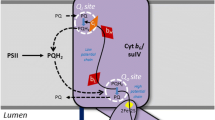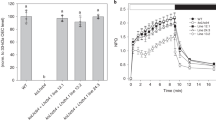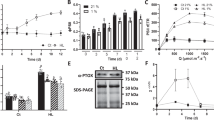Abstract
Light, controls the “blueprint” for chloroplast development, but at high intensities is toxic to the chloroplast. Excessive light intensities inhibit primarily photosystem II electron transport. This results in generation of toxic singlet oxygen due to impairment of electron transport on the acceptor side between pheophytin and QB -the secondary electron acceptor. High light stress also impairs electron transport on the donor side of photosystem II generating highly oxidizing species Z+ and P680+. A conformationsl change in the photosystem II reaction centre protein Dl affecting its QB-binding site is involved in turning the damaged protein into a substrate for proteolysis.
The evidence indicates that the degradation of D1 is an enzymatic process and the protease that degrades D1 protein has been shown to be a serine protease Although there is evidence to indicate that the chlorophyll a-protein complex CP43 acts as a serine-type protease degrading Dl, the observed degradation of Dl protein in photosystem II reaction centre particlesin vitro argues against the involvement of CP43 in Dl degradation. Besides the degradation during high light stress of Dl, and to a lesser extent D2-the other reaction centre protein, CP43 and CP29 have also been shown to undergo degradation.
In an oxygenic environment, Dl is cleaved from its N-and C-termini and the disassembly of the photosystem II complex involves simultaneous release of manganese and three extrinsic proteins involved in oxygen evolution. It is known that protein with PEST sequences are subject to degradation; D1 protein contains a PEST sequence adjacent to the site of cleavage on the outer side of thylakoid membrane between helices IV and V.
The molecular processes of “triggering” of Dl for proteolytic degradation are not clearly understood. The changes in structural organization of photosystem II due to generation of oxy-radicals and other highly oxidizing species have also not been resolved. Whether CP43 or a component of the photosystem II reaction centre itself (Dl. D2 or cy1 b559 subunits), which may be responsible for degradation of Dl, is also subject to light modification to become an active protease, is also not known. The identity of proteases degrading Dl, LHCII and CP43 and C29 remains to be established
Similar content being viewed by others
References
Anderson J M and Osmond C B 1987 Shade sun responses: Compromises between acclimation and photoinhibition. inPhotoinhibition (eds) D I Kyle, C B Osmond and C J Arntzen (Amsterdam; Elsevier) pp 1–38
Andersson B 1994 Proteolytic activities associated with photosystem II and its light harvesting apparatus; inXVIInt. Congr. Biochem. MolBiol., New Delhi, vol. 3. pp 37
Andersson B and Styring S 1991 Photosystem II; Molecular organization, function and acclimation;Curr. Top. Bioenerg. 16 1–81
Aro E M, Hundal T, Carlbecg I and Andersson B 1990In vitro studies on light induced inhibition of photosystem II and D-l protein degradation at low temperatures;Biochim. Biophys. Acra 1019 269–275
Aro E M, Virgin I and Andersson B 1993 Photoinhibition of photosystem II motivation, protein damage and turnover;Biochim. Biophys. Ada 1143 113–134
Asada K and Takahashi M 1987 Production and scavenging of active oxygen in photosynthesis; inTopics in photosynthesis: Photoinhibition (eds) D J Kyle. C B Osmond and C J Arntzen (Amsterdam; Elsevier) vol.9, 227–288
Barbato R, Shipton C A, Giacometti G M and Barber J 1991 New evidence suggests that the initial photoinduced cleavage of D-l protein may not occur near the PEST sequence;FEBS Leu. 290 162–166
Barbato R A, Frizzo G, Friso F. Rigoni and Giacometti G M 1992 Photoinduced degradation of the Dl protein in isolated thylakoids and various photosystem II particles after donorside inactivations. Detection of a C-terminal 16 kDa fragment;FFBSLeu. 304 136–140
Barber J, Chapman D J and Telfer A 1987 Characterization of a PS II reaction centre isolated from the chloroplastsof Pisum sativum;FEBS Lett. 220 67–73
Barber J and Anderson B 1992 Too much of a good thing: Light can be bad for photosynthesis;Trends Biochem. Sci. 17 61–66
Barry B A and Babcock 1987 Tyrosine radicals are involved in the proteolytic oxygen evolving system;Proc. Natl. Acad. Sci. USA 84 7099–7103
Blobaugh D J and Cheniae G M 1990 Kinetics of photoinhibition in hydroxylamine-extracted photosystem II membranes identification of the sites of photodamage;Biochemistry 29 5109–5118
Callaban F A. Ghirardi M L, Sopory S K, Mehta A M, Edelman M and Mattoo A K 1990 A novel metabolic form of the 32 kDa D-l protein in the grana localized reaction centre of photosystem II;J. Biol. Chem. 265 15357–15360
Dostatni R. Meyer H E and Oettmeier W 1988 Mapping of two lyrosine residues involved in the quinone-(QB) binding site of D-l reaction centre polypeptide of photosystem II;FFBS I.ett 239 207–210
Dwivedi U and Bhardwaj R 1994 Cyrochromeb a-f complex; The carburettor of exciton distribution in oxygenic photosynthesis;J. Biosci,19 37–42
Eyal Y, Goloubinoff P and Edelman M 1987 The amino terminal region delimited by Met I and Met 37 is an integral part of the 32 kDa herbicide binding protein;Plant Mol. Biol. 8 337–343
Formm H, Devic M, Fluhx R and Edelman M 1985 Controlof psbA gene expression in natureSpirodeta chloroplasts. Light regulation of 32 kDa protein synthesis is independent of transcript level:EMBO J. 4 291–295
Friso G, Giacometti G M, Barber J and Barbato R 1993 Evidence for concurrent donor and acceptor side photoinduced degradation of the Dl-protein in isolated reaction centres of Photosystem II;Biochim. Biophys. Acta 1144 265–270
Funk C, Schroder W P, Green B R, Renger G and Andersson B 1994 The intrinsic 22 kDa protein is a chlorophyll-binding subunit of photosystem II;FEBS Lett. 342 261–266
Greenberg B M, Gaba V, Mattoo A K and Edelman M 1987 Identification of a primaryin vivo degradation product of the rapidly turning-over 32 kd protein of photosystem II;EMBO J. 6 2865–2869
Gruissem W and Zurawski G 1985 Analysis of promoter regions for the spinach chloroplastrbc L, atp B and pub A genes;EMBO J. 4 3375–3383
Horton P 1989 Interaction between electron transport and carbon assimilation: Regulation of light harvesting and photochemistry;Photosynthesis Plant Biol. Ser. 8 393–406
Hundal T, Aro E-M, Carlberg I and Andersson B 1990 Restoration of light induced photosystem II inhibition withoutde novo protein synthesis;FEBS Lett. 267 203–206
Inagaki N, Fujita S and Satoh K 1989 Solubilization and partial purification of a thylakoid enzyme of spinach involved in the processing of Dl protein;FEBS Lett. 246 218–222
Jegerschold C, Virgin I and Styring S 1990 Light-dependent degradation of the Dl protein in photosystem II is accelerated after inhibition of the water splitting reaction;Biochemistry 29 6179–6186
Jennings R C and Zucchelli G 1985 The influence of membrane stacking on light absorption by chloroplasts;Photobiochem. Photobiophys. 9 215–221
Klein R R, Mason H S and Mullet J E 1988 Light regulated translation of chloroplast proteins. Transcripts ofpsaA psaB, psbA andrbcL are associated with polysmes in dark grown and illuminated barley seedlings;J. Cell Biol. 106 289–301
Kuwabara T and Murata N 1982 Inactivation of photosynthetic oxygen evolution and concomitant release of three polypeptides in the photosystem II panicles of spinach chloroplasts;Plant Cell Physiol. 23 533–539
Kuwabara T, Miyao M, Murata T and Murata N 1985 The function of 33-kDa protein in the photosynthetic oxygen evolution system studied by reconstitution experiments;Biochim. Biophys. Acta 806 283–289
Kyle D J, Ohad I and Arntzen C J 1984 Membrane protein damage and repair: selective loss of quinone-protein function in chloroplast membranes;Proc. Natl. Acad. Sci. USA 81 4070–4074
Kyle D J 1987 The biochemical basis for photoinhibition of photosystem II; inTopics in photosynthesis (eds) D J Kyle, C B Osmond and C J Arntzen (Amsterdam: Elsevier) vol. 9, pp 197–226
Link G 1982 Phytochrome control of plastid mRNA in mustard (Sinapis alba L);Planta 154 81–86
Marder J B, Golonbinoff P and Edelman M 1984 Molecular architecture of the rapidly metabolized 32-kilodalton protein of photosystem II;J. Biol. Chem. 259 3900–3908
Marder J B, Chapman D J, Telfer A, Nixon P J and Barber J 1987 Identification ofpsbA andpsbD gene products, Dl and D2, as reaction centre proteins of photosystem 2;Plant Mol. Biol. 9 325–333
Mattoo A K, Hoffman-Falk H, Marder J B and Edelman M 1984 Regulation of protein metabolism coupling of photosynthetic electron transport toin vivo degradation of the rapidly metabolized 32-kilodalton protein of the chloroplast membranes;Proc. Natl. Acad. Sci. USA 81 1380–1384
Mattoo A K, Marder J B and Edelman M 1989 Dynamics of the Photosystem II reaction center;Cell 56 41–246
Michel H, Hunt D F and Shabano Witz J 1988 Tandom mass spectroscopy reveals that three PS II proteins of spinach chloroplasts contain N-acetyl O-phosphothreonine at their N-termini;J. Biol. Chem. 263 1123–1130
Mishra N P, Francke C, van Gorkam H J and Ghanotakis D F 1994 Destructive role of singlet oxygen during aerobic illumination of the photosystem II core complex;Biochim. Biophys. Acta 1186 81–90
Mullet J E, Klein P G and Klein R R 1990 Chlorophyll regulates accumulated of the plastid-encoded chlorophyll-apoproteins CP43 and Dl by increasing apoprotein stability;Proc. Natl. Acad. Sci. USA 87 4038–4042
Nanba O and Satoh K 1987 Isolation of a photosystem II reaction center consisting of D-l and D-2 polypeptide and cytochrome B559;Proc. Natl. Acad. Sci. USA 84 109–112
Oettmeier W, Masson K and Johanningmeier U 1980 Photoaffinity labeling of the photosystem II herbicide binding protein;FEBS Lett. 118 267–270
Ohad I, Kyle D J and Hirschberg J 1985 Light dependent degradation of QB-protein in isolated thylakoids;EMBO J. 4 1655–1659
Powles S B 1984 Photoinhibition of Photosynthesis induced by visible light;Annu. Rev. Plant Physiol. 35 15–44
Prasil O, Adir N and Ohad I 1992 The Photosystems: Structure, function and molecular biology; inTopics in photosynthesis (ed.) J Barber (Amsterdam: Elsevier), vol. 11, pp 220–250
Richter M, Ruhle W and Loild A 1990 Studies on the mechanism of photosystem II photoinhibition. I. A two step degradation of Dl protein;Photosynth. Res. 24 229–235
Salter H A, Virgin I, Hagman A and Andersson B 1992 On the molecular mechanism of light induced Dl protein degradation in photosystem II core particles;Biochemistry 31 3990–3998
Satoh K, Nakatani H Y, Stainback K E, Watson J and Amtzen C J 1983 Polypeptide composition of a photosystem II core complex. Presence of herbicide binding protein;Biochim. Biophys. Acta 724 142–150
Schuster G, Shochat S, Adir N and Ohad I 1989 Inactivation of photosystem II and turnover of the D-l protein by light and heat stresses;NATO ASI-Ser A;Life Sci. USA 168 499–510
Setlik I, Allakhverdiev S I, Nedbal L, Setlikova E and Klimov V V 1990 Three types of photosystem II photoinactivation. I. Damaging processes on the acceptor side;Photosynth. Res. 23 39–48
Sopory S K, Greenberg B M, Mehta R A, Edelman M and Mattoo A K 1990 Free radical scavengers inhibit light-dependent degradation of the 32 kDa Photosystem II reaction center protein;Z. Naturforsch. 45c 412–417
Styring S, Virgin I, Ehrenberg A and Andersson B 1990 Strong light photoinhibition of electron transport in Photosystem II Impairment of the function of the first quinone acceptor. QA;Biochim. Biophys. Acta 1015 269–278
Takahashi M, Shirashi T and Asada K 1988 COOH-terminal residues of Dl and 44 kDa CPa-2 at spinach photosystem II core complex;FEBSLett. 240 6–8
Tang X S and Satoh K 1985 The oxygen evolving photosystem II core complex;FEBS Lett. 179 60–64
Theg S M, Filar L J and Dilley R A 1986 Photoinactivation of chloroplasts already inhibited on the oxidizing side of photosystem II;Biochim. Biophys. Acta 849 104–111
Trebst A 1987 The three-dimensional structure of the herbicide biniding niche on the reaction centre polypeptides of photosystem II;Z Naturforsch. 42c 742–750
Trivedi P K, Nath P and Sane P V 1994 Characterization ofpsbA gene from chloroplasts ofPopulus deltoides;J. Plant Biochem. Biotech. 3 97–102
van der Bolt F and Vermass W 1992 Photoinactivation of photosystem II as studied with site-directed D2 mutants of the cyanobacteriumSynichocystis sp. PCC 6803;Biochim. Biophys. Acta 1098 247–251
Vass I, Gatzen G and Holzwarth A R 1993 Picosecond time resolved fluorescence studies on photoinhibition and double reduction of QA in photosystem II;Biochim. Biophys. Acta 1183 388–396
van-Wijk K L, Andersson B and Styring S 1992 Spectroscopic characterization of photoinhibited photosystem II and kinetic resolution of the triggering of the Dl reaction centre protein for degradation;Biochim. Biophys. Acta 1100 207–215
Virgin I, Styring S and Andersson B 1988 Photosystem II disorganization and manganese release after photoinhibition of isolated spinach thylakoid membranes;FEBS Lett. 233 408–412
Virgin I, Ghanotakis D F and Andersson B 1990 Light induced Dl protein degradation in isolated photosystem II core complexes;FEBSLett. 269 45–48
Virgin I. Salter A H, Ghanotakis D F and Andersson B 1991 Light induced protein degradation is catalysed by a serine type protease;FEBSLett. 287 125–128
Virgin I, Salter A H, Hagman A, Vass 1, Styring S and Andersson B 1992 Molecular mechanisms behind light-induced inhibition of photosystem II electron transport and degradation of reaction centre polypeptides;Biochim. Biophys. Acta. 1101 139–142
Zurawski G, Bonhert H-J, Whitfield P R and Bottomley W 1982 Nucleotide sequence of the gene for the 32000-M, thylakoid membrane protein fromSpinacia oleracea andNicotiana debneyi predicts a totally conserved primary translation product of Mr 38950;Proc. Natl. acad. sci. USA 79 7699–7703
Author information
Authors and Affiliations
Rights and permissions
About this article
Cite this article
Dwivedi, U., Bhardwaj, R. D1 protein of photosystem II: The light sensor in chloroplasts. J. Biosci. 20, 35–47 (1995). https://doi.org/10.1007/BF02711579
Received:
Revised:
Published:
Issue Date:
DOI: https://doi.org/10.1007/BF02711579




